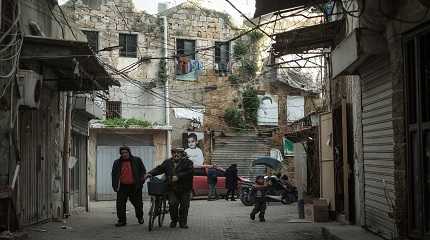
BEIRUT, Mar 5 (NNN-XINHUA) – In the past weeks, since the massive earthquake hit Türkiye and Syria on Feb 6, Ebtisam Antar, a mother of two in Lebanon’s neighbouring Syria, goes to bed every night with intense fear that the roof of her 50-year-old house may fall over her head.
She told Xinhua that the quake on Feb 6, caused cracks in the wall of her balcony before another one two days later led to more fissures in her daughter’s bedroom.
“I was scared to death, so I moved from the house on Feb 6, with my two kids. But I had to return 20 days later because I can’t stay at my brother’s crowded house forever,” said Antar, who lives in a poor neighbourhood, in the northern Mediterranean city of Tripoli.
The situation is even worse for Mustafa el-Wahesh, as the quake added new cracks in the iron columns of his 50-year-old building, which has long been severely troubled by its poor sewage.
“My family and I are so scared that we sleep with our day clothes on,” el-Wahesh told Xinhua.
“But I could not even leave the house as I have nowhere to go,” the father of two lamented.
Antar and el-Wahesh’s plights reveal the fragility of aging buildings in Tripoli because of decades of neglect, especially after the deadly earthquake that killed over 47,000 in Syria and Türkiye.
Even before the 2019 financial collapse, residents in the Mediterranean impoverished Lebanese city lacked the financial resources to maintain their buildings.
Mohammad Dabab, a third resident in Tripoli, said, his building was “dancing right and left” during the earthquake and he can still feel it moving even if there is no quake.
“Walls and iron columns cracked. Architects who came to check our building said the situation is dangerous,” he told Xinhua.
The Order of Engineers and Architects in Tripoli has visited and checked the buildings damaged by the earthquake in the northern Lebanese city, hoping to submit a report to authorities for support for the buildings, at risk of collapse, explained Fadi Obeid, an engineer and member of the local organisation.
Hundreds of complaints are now filed every day by residents in Tripoli, who worry about the safety of their homes, according to Obeid and Ahmad Amareddine, the head of Tripoli’s municipality.
Amareddine told Xinhua, about 700 to 800 buildings in Tripoli were cracked at different degrees even before the earthquake but are not at risk of collapse in the absence of new natural disasters.
He puts the number of constructions at risk of collapse from the recent earthquake at 20, while Obeid believes the real figure is much higher, through the field visits by the teams of his organisation.
Mohamad Kheir, secretary general of the Higher Relief Committee in Lebanon, told Xinhua, the government plans to provide housing allowances for owners whose houses risk collapsing.
Last month, the Order of Engineers and Architects of Tripoli, in cooperation with the Association of Arab Architects, based in the capital Beirut, issued a series of recommendations during a conference held in the city, where conferees agreed on the urgency to launch a survey of cracked buildings in Tripoli, that pose a threat to public safety, calling on the authorities to secure funding dedicated to restoring and strengthening those buildings.




